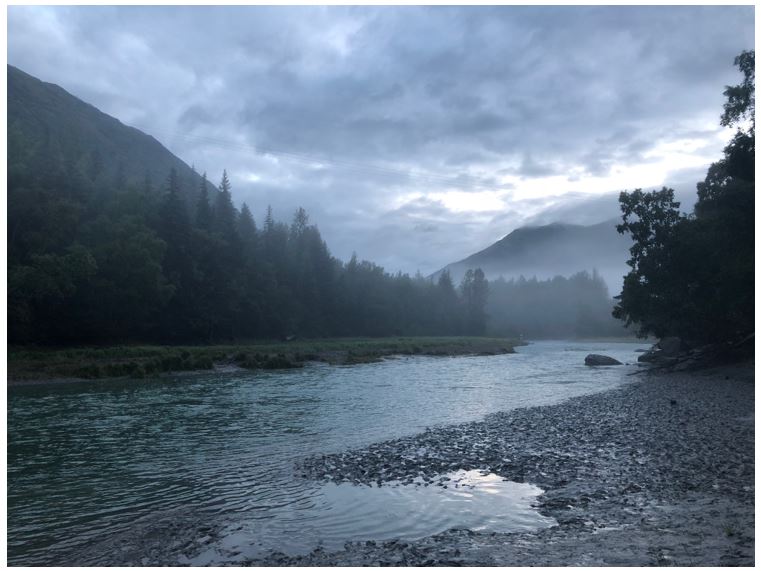This morning at 5:30AM, your editor was fishing for coho salmon from the muddy shores of Bird Creek, near Anchorage, Alaska.
 |
Source: Taylor Kee |
This specific section of creek is wildly popular for salmon fishing. As the tide ebbs, the fish are corralled into a central channel, which allows fishermen to target their casts easily.
At the peak of the run, many fishermen can catch their limit — three fish — in under five minutes.
Your editor took a little longer. Even though a highly experienced local fisherman accompanied me, it took around an hour to find the sweet spot.
Once we found it, it was ‘pop pop pop’ — three beautiful fish…around 4.5 kilos each.
But while we were out casting and reeling, my friend told me a bit about the salmon that I found fascinating…and curiously suited to today’s topic.
You see, coho salmon — or ‘silvers’ as my friend calls them — spawn in freshwater. The eggs are deposited in gravel bars in creeks and small rivers.
Within the next year of hatching, the young fish will mature and swim out into the ocean, where they’ll eat a diet of krill, anchovies and herring.
They can swim quite far from where they’re born. Significant populations can be found from California, up along Alaska, to Russia and Japan.
After getting nice and fat out in the open waters for a couple of years, it’ll be time for them to reproduce. At this time, the fish smell their ways back to the exact gravel bar where they were born.
The salmon will swim upstream until they find the spot…and they’ll lay their own roe.
Then both the male and female die.
That’s right. Once the salmon reproduce, they die. You’ll find deteriorating fish all along the creek pictured above.
In fact, while I was fishing, I spotted a couple ‘zombie’ fish. These were a different type of salmon that had already reached the end of their lifespan. They were dark and splotchy…swimming slowly along the waters edge…waiting to die.
‘You don’t want those,’ my friend told me. ‘Those fish are na-a-asty.’ [openx slug=inpost]
Nature’s cycle
The life cycle of salmon is a short tale. You’re born. You get fat. You reproduce. You die. (Not unlike us humans).
It may seem sad that the salmon die soon after laying their eggs…but it’s how nature has worked it out. And the result is that, over time, the coho salmon population has exploded to healthy sustainable numbers.
That’s what got me thinking…
Nature has perfected this cycle. And yet it requires the fish to die after living only a few years.
If we wanted, we could try to manipulate it so that the fish can live longer lives.
We could block the estuaries — force the fish to stay out in the ocean. They might live a few more years…but eventually they’d die anyways. And this time, there’d be no new generation to help the population rebound.
It could very well kill the species.
No, the best thing to do is to let them live through their natural cycle. Over the long run, you’d be rewarded with plentiful harvests and thriving coho salmon populations.
The same idea holds true in economics.
The economic cycle starts with rapid growth — a bull run. During this time, portfolios are becoming plump with high returns. Investors are happy. Life’s good.
That’s what we’ve been experiencing in New Zealand for over a decade.
Eventually, it comes time for the next stage — the bear market. Stock prices fall. Confidence ebbs. Returns deteriorate.
For those experiencing it for the first time, it can be scary. But veteran investors will recognise it as a natural part of the market’s life cycle.
Here’s an aside: even though it’s a natural part of the cycle, that doesn’t mean you can’t prepare and safely ride out the storm. Bill Bonner, Vern Gowdie and others in our network focus their strategies on precisely this scenario.
Then every bear market ends with the rebirth of the bull market…and the cycle continues.
Over time, the economy tends to grow. Two steps forward; one step back.
Only now, it’s more like ’10 steps forward — and we’re never going back’.
Central bankers and politicians have decided that they don’t like the cycle. They want the economy to be in a continuous upward trend.
So they introduce measures like quantitative easing (QE) and low interest rates. They bail out dying companies in the name of ‘too-big-to-fail’.
In essence, they block the estuary so that the fish keep living out in the ocean.
And that, in turn, can do serious long-term damage.
Here at Money Morning New Zealand, we believe that the market naturally needs to go through bear markets. It requires corrections and adjustments.
It’ll bounce back. And when it does, it’ll be stronger than ever. History has proven it.
When the authorities intervene, they throw a wrench in the works. And nobody really knows what happens next.
That’s one can of worms I’m afraid to open.
Until next time.
Best,
Taylor Kee
Editor, Money Morning New Zealand





Taylor Kee is the lead Editor at Money Morning NZ. With a background in the financial publishing industry, Taylor knows how simple, yet difficult investing can be. He has worked with a range of assets classes, and with some of the world’s most thought-provoking financial writers, including Bill Bonner, Dan Denning, Doug Casey, and more. But he’s found his niche in macroeconomics and the excitement of technology investments. And Taylor is looking forward to the opportunity to share his thoughts on where New Zealand’s economy is going next and the opportunities it presents. Taylor shares these ideas with Money Morning NZ readers each day.